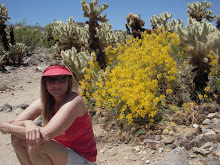 In Part I of this interview I talked with Curt Sauer, veteran of the National Park Service and superintendent of Joshua Tree National Park. We talked about how he came to work at the park, what his job is like, and visitors' favorite sites. Check it out here if you missed it.
In Part I of this interview I talked with Curt Sauer, veteran of the National Park Service and superintendent of Joshua Tree National Park. We talked about how he came to work at the park, what his job is like, and visitors' favorite sites. Check it out here if you missed it.Allison: Curt, what are your concerns regarding Joshua Tree National Park?
Curt: I'm concerned that Joshua Tree National Park will become an island surrounded by human development and walled communities, with population growth specifically outside the north and south park boundaries, and the fact that plants and wildlife will not be able to migrate and move through those communities.
In the next 20 years, by some estimates 100,000 people are expected to move into the Morongo Basin. The arrival of a Home Depot in Yucca Valley last October and of a planned Super-Walmart this coming year predicts future growth. The cities of Yucca Valley and 29 Palms would also like to preserve those open spaces.
Allison: What other concerns do you have regarding the park?
Curt: In Paradise Valley, north of Interstate 10, in Pinkham Canyon, four miles from Joshua Tree National Park, plans have been proposed for a planned community of 30-40,000 people. Feral cats, domestic cats and dogs, and the lights at night would impact the park's insects and owls.
Ivanpah Valley Airport, being built in Ivanpah, Nevada, will be in operation by 2017. The Ivanpah Valley Airport will grow larger than McCarran Airport in Las Vegas. According to a state report, an additional eight million people will be moving into Southern California from Bakersfield south. They'll need to recreate somewhere.
Eventually, mountain lion, deer, and bobcat populations may not be able to readily move from the San Bernardino Mountains to the Little San Bernardino Mountains in the park, which will further isolate the park's populations.
A Los Angeles DWP Green Path has been proposed--a 200 foot tall, 500 kilowatt transmission line that will start east of Highway 62. To be gained in part by eminent domain, the line would run through Big Morongo Canyon Preserve and Pioneertown, and feed into Victorville. The term "green" is a misnomer. Only 20% of the energy would come from geothermal solar fields near the Salton Sea and Imperial Valley.
A proposed landfill near Eagle Mountain, adjacent to the park, would put garbage on pristine land. It's the cumulative effect of all these things that will impact Joshua Tree National Park.
Allison: Talk about The Centennial Act.
Curt: To prepare for the National Park Service's 100th Anniversary in 2016, Congress recently passed the Centennial Act, the first of 10 years of additional funding--with a $100 million base this year alone, over and above a cost-of-living increase--for the national parks. This will enable us at Joshua Tree National Park to double our volunteer staff and hire 29 seasonal employees from Centennial Act monies--14 interpreters, 11 rangers, and 4 maintenance workers.
The current administration, and Laura Bush, the Honorary Chair of the Junior Ranger Program, loves our national parks. Support of the national parks changes by personal interest, not by political party.
Allison: Tell us about renovations taking place in the park in the future.
Curt: We have used$17 million of Federal Highways Funds over the past 8 years to repair and replace 22 miles of roads along Route 12 and Keys View. By 2011 we'll start to work on the road to Cottonwood (the park's south entrance).
In Part III of this interview Curt will talk about the many things he takes pride in at Joshua Tree National Park.

No comments:
Post a Comment